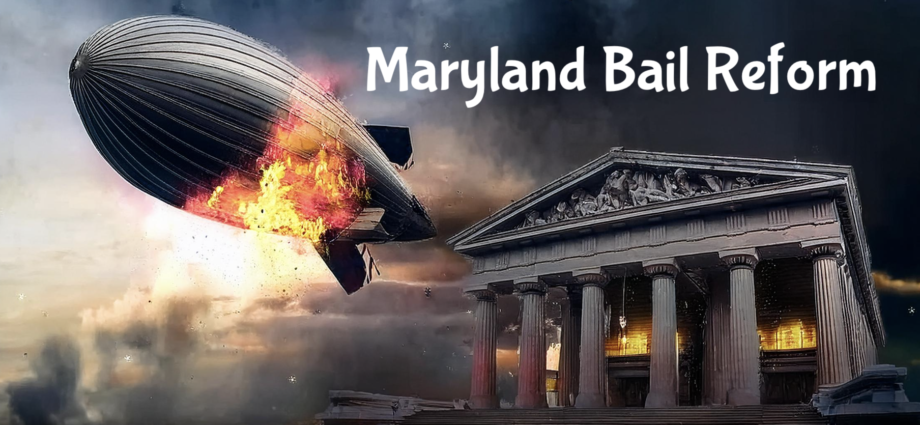Study: Eight Year Experiment Ending Cash Bail in Maryland Increased Mass Pretrial Incarceration All While Arrests Went Down and Crime Went Up
In 2017, we mounted a campaign against the Maryland “end cash bail” court rule change implemented by the Maryland Court of Appeals because eliminating bail in favor of a system of risk-based preventative detention would, over time, swallow up the system and create economic and other perverse incentives to increase not decrease pretrial detention. We argued (well, Professor Tribe argued) that labeling people as dangerous and then tossing them in jail based on this labeling is something from which even a jury finding of innocent could not exonerate, thus creating an inevitable feedback-loop in favor of greater detention. We called it the march toward preventative detention.
Unfortunately, we were right.

We also hired former Solicitor General Paul Clement to go in and make the case that bail, as a “liberty-promoting institution,” was the preferred framework to work from for the question was truly not whether we should use preventative detention but rather whether someone should get out without having to post bail at all, a system of bail or release on own recognizance. Of course, in the post-Bruen era, the argument that the entire preventative detention scheme lacks historical support at the framing of the constitution has new life, in addition to the fact that the Supreme Court renounced one of the key precedents upon which preventative detention in Salerno was first built, the Korematsu case regarding the illegal internment of Americans of Japanese ancestry occasioned by Executive Order 9066.
Now, in a new study released this week, it is clear that the Maryland Court of Appeals end cash bail rule has increased the overall rate of pretrial detention in the name of protecting the indigent poor who can’t afford their bail. At the time of implementation in 2017, roughly 47% of defendants were released from custody. Today, only 36% of defendants are released from custody pending trial. Thus, the overall rate of pretrial incarceration has increased by over 20% during the intervening eight years. That crime has not fallen is not something we need not get into. In addition, arrests fell by a third, and then, to add insult to injury, the people they tossed in the ’can using preventative detention are now taking way, way too long to process their cases. Just like the Federal Bail Reform Act of 1984, where times to disposition have gone from 60 days to 360 days, Maryland is now taking much, much longer to resolve cases. So, the result is we are catching fewer people doing crimes, putting them in jail purgatory longer thus increasing jail costs, and then at the same time increasing crime because fewer people are getting caught and punishments less swift and thus less deterrence.
READ THE STUDY: AFTER BAIL REFORM EFFORT, BALTIMORE RESIDENTS ARE BEING HELD IN JAIL AT HIGHER RATES THAN BEFORE
Said the advocates upon hearing the news that the entire program sank like the Hindenburg: “It is quite painful.”
Colin Starger, a local law professor over in Baltimore, said it best by saying that “everybody knows” that the “people that used to be held on unaffordable bails are just being held without bond.” Of course, he fails to mention at a rate 20% higher than those pesky unaffordable, less-incarcerating monetary bonds.
States are the laboratories of democracy as Justice Brandeis once said, and while many of those experiments succeed, the Maryland risk-based preventative detention system used when the state decided to end monetary bail has completely failed. Indeed, there could be no more a complete failure of the end cash bail experiment based on what was promised.
As to the presumption of innocence…in Maryland they think from the get-go that 64% of people are dangerous and should be tossed in jail with no possibility of liberty or bail based on unproven allegations made by prosecutors long before a jury ever convicts. That folks, is what failure looks like.
The system of security or no-security we know offers the framework for the right balance in our system. That’s why the framers intended the institution of bail to be the balance. It is just sad that no one listened to us then, but tragic that the persuasive words of one of the most learned advocates of our time fell on the deaf ears of judges, who now should be vigorously held to meticulous account for this villainous affront to what was the well-settled right to bail by sufficient sureties in the great State of Maryland.
That we told them so is unfortunately of little relief to us or the found innocent that sat behind bars in Maryland in greater numbers because now there is no incentive to get to the fork in the road of guilt or innocence when the 64% who are “dangerous” are already there. To all we say, give them bail.



Facebook Comments